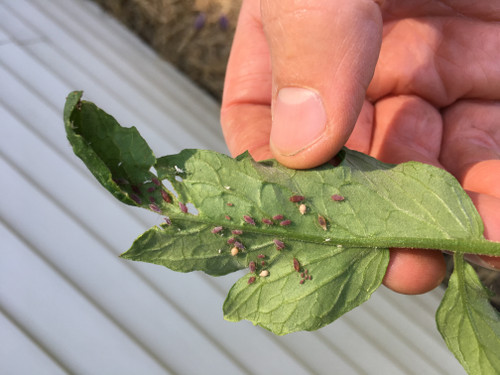Insect Pests of Tomatoes
Posted by Eli on 26th Jul 2019
When you grow your tomato plants, there are high chances that they will be attracted to some insect pests that commonly attack tomato plants and fruits. Here's some basic information on several widespread pests that are interested in tomatoes just like you.
Aphids can bother tomato plants all season long. These soft-bodied, pear-shaped insects may be green, pink or yellow. They suck the sap from plants, weakening them and, indirectly, spread diseases. Wash them from plants with a shot from your garden hose every few days, and if they persist, use insecticidal soap.
Beetle Pests. Blister beetles and Colorado potato beetles both feed on tomato foliage. The 1/2- to 3/4-inch-long, black, gray, brown or yellow blister beetles generally don't do much damage. Just keep an eye out when harvesting tomatoes; if you crush one of these beetles, its juices can cause your skin to blister. The Colorado potato beetle is a more voracious feeder. Adult beetles are orange and black striped; the large, orange humpbacked larvae have two rows of black dots down their sides. Both of these pests can be controlled with diligent hand-picking.
Cutworms are grey, brown or black pests that curl up tightly when disturbed. They're one to 1-1/2 inches long, hide in the soil during the day and come out at night to feed on young plants. They'll chew tomato transplants right off at the soil surface. There's no need to spray for these pests in the home garden. Simply put a newspaper collar around the tender stem at transplanting time, spanning at least one inch above and two inches below ground.
Flea Beetles are tiny, 1/16-inch-long black beetles that jump like fleas and chew numerous small holes in the leaves, most often early in the season. Damage on established plants usually isn't serious, but young seedlings can be badly weakened by flea beetle feeding. To control, spray or dust with an approved insecticide, such as pyrethrum. Adult beetles spend the winter in plant debris, so clean up the garden well in the fall.
Hornworms are many gardeners' least favorite pest. These huge, green caterpillars with a "horn" on their back ends eat both leaves and tomatoes. They work fast, too. Handpicking is the best bet in the home garden because you often discover the pests at harvest time when it's unwise to spray with chemical insecticides. (The "horn" is fierce-looking, but harmless.) If you prefer to spray, use Bacillus thuringiensis (known as Bt, and available as Dipel or Thuricide), a natural insecticide that requires no waiting between application and harvest. This form of Bt only infects caterpillars. It is most effective if used when the caterpillars are small. Bt can kill the larvae of all species of butterfly or moth, so be sure to use care during application to minimize drift.
Stinkbugs are 5/8-inch-long, shield-shaped insects may be green, gray, blue or red. Like aphids, they feed by sucking the plants' sap. This causes deformed fruits with hard, whitish spots on them. To control stinkbugs, reduce their habitat by keeping weeds under control, both in the garden and surrounding. Cover plants with floating row cover to create a barrier against the pests.
Tomato fruit worm are a season-long pest that feed on tomato foliage and fruits. These yellow-, green- or brown-striped caterpillars can grow up to two inches long. Spray with Bt for control. Destroy infested fruits and clean up all tomato plant debris at the end of the season to reduce the number of overwintering insects.
Whiteflies feed on many plants in the vegetable garden besides tomatoes, including cucumbers and melons. These tiny (1/16-inch-long) pests fly out in a cloud from infested plants when disturbed. They feed by sucking the plants' sap, causing leaves to become yellow and distorted and weakening plants. Whiteflies secrete a sugary substance called honeydew on which a sooty black mold often grows, making tomato leaves appear dirty. Spray with insecticidal soap for control.
If you use any kind of spray follow the directions exactly. It's always good to use organic or natural sprays as much as possible. If you have any questions/need an advice, feel free to always contact us at admin@theseedsmaster.com for more information and help.


